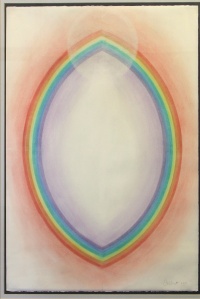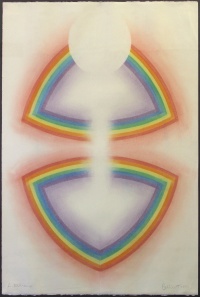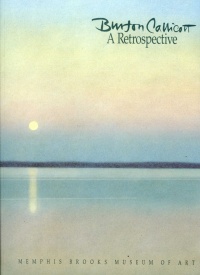Burton Callicott
Burton Harry Callicott was a Theosophist from Memphis, Tennessee who incorporated Theosophical concepts into his paintings and drawings. His work has been described as "the relationship between nature and the human spirit, epitomized in the effects of light."[1] Three of his paintings were donated by the artist and his family for the collection of the Theosophical Society in America: Antahkarana, Mandorla, and Mandorla #12.
Early life and education
Callicott was born December 28, 1907 in Terre Haute, Indiana. After graduation from the Cleveland School of Art in 1931, he returned to Memphis to teach in public schools. Like many Depression-era artists, he found temporary employment under a federal agency. The Federal Public Works of Art Program commissioned him to paint murals for the stairway of the Memphis Pink Palace Museum. The exploration of the Mississippi River by Hernando de Soto was the subject of the murals.[2]
During this period, Callicott began working with his stepfather Michael Abt in the design of floats for the Memphis Cotton Carnival and Christmas parades. They shared this activity for 20 years beginning in 1932.
Personal life
Evelyne Baird married Burton Callicott in 1932, and they spent more than 60 years together. The couple had two children. Their small house in Memphis had an artist's studio with north-facing skylight and rainbows hanging in the window.[3]
Involvement with Theosophy
Early in the 1960s, Callicott developed in interest in Theosophy. He joined the Theosophical Society in America in 1959 and became a life member,[4] For many years he participated in the Memphis Lodge activities, and he wrote articles for Theosophical periodicals. He considered himself to be mystically inclined, but not a mystic.[5]
Art works
Light contrasted with shadows, and light refracted into rainbows are frequent components of Callicott's art. He prepared his own canvases, acetate stencils, and frames. His technique involved many layers of transluent glazes, and he often had to restretch his canvas repeatedly.
Exhibitions
The Memphis Academy of Art, now the Memphis College of Art, exhibited Callicott's work in 1971
In 1991, the Memphis Brooks Museum of Art held a retrospective exhibition of the artist's work, curated by Patricia P. Bladon. Callicott was then 83 years old. Forty-works?? were exhibited and a beautiful exhibition catalog was issued. The cover shows a fragment of Callicott's 1980 work, Moonrise Over Nauset Beach, which is executed in oil on canvas.
Later years
Mr. Callicott died on November 23, 2003.
Additional resources
Callicott's papers in in the Smithsonian Institution. Slides of his works are available in that collection, and also at the Memphis College of Art.
A video biography of the artist called "Journeyman of Light" was produced by Jim Crosthwait for the Memphis Art Gallery Association in 1991.
Notes
- ↑ Fredric Koeppel, "A Life on Canvas:Callicott Reflects on Limitless Art Career," Memphis Commercial Appeal, February 24, 1991.
- ↑ Ibid.
- ↑ Ibid.
- ↑ Membership database and microfilm records. Theosophical Society in America Archives. Callicott's member ID number was 010810.
- ↑ Fredric Koeppel, "A Life on Canvas:Callicott Reflects on Limitless Art Career," Memphis Commercial Appeal, February 24, 1991.


